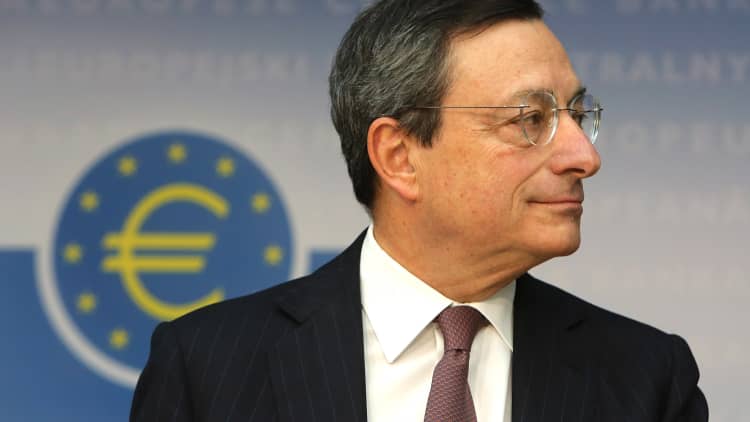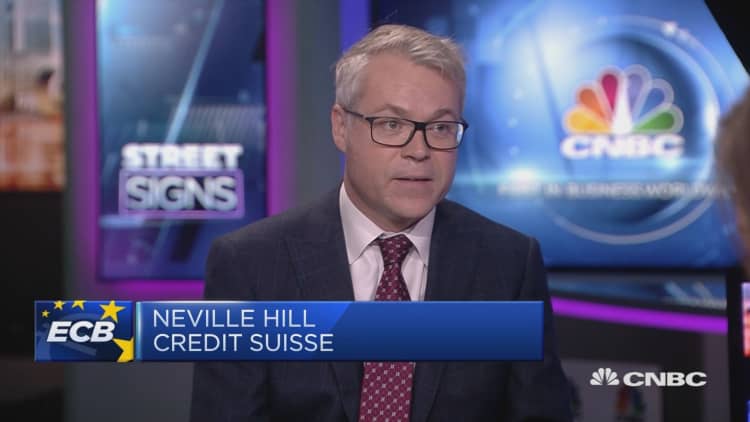The shape and size of the European Central Bank's new bond-buying program caught market participants off guard, with some now predicting it'll be years until the euro zone is back to anything approaching normality.
Starting in November, the ECB will make 20 billion euros ($21.9 billion) of net asset purchases per month for as long as it takes for the euro zone's inflation and growth outlooks to return to satisfactory levels. The purchasing will only end "shortly before" the next rate hike.
ECB President Mario Draghi pointed out Thursday that a major reason for the re-launch of net asset purchases was that inflation expectations remained consistently below the ECB's target of just below 2%, but implored governments to deploy fiscal policy to supplement his actions.

This will be the second round of quantitative easing (QE) from the ECB, the first coming four years ago in response to the calamitous euro zone debt crisis.
Shweta Singh, managing director of global macro at TS Lombard, said the second round of asset purchases would likely have a "milder impact than QE-I, when borrowing costs were higher, fragmentation across the euro area was severe and domestic risks were far greater."
"Crucially, there may be much less scope this time for the euro to edge lower and thus boost inflation expectations, while the pool of eligible assets that the ECB can buy has shrunk since QE-I was launched."
QE infinity?
The smaller increments but open-ended timescale of this second package (QE-II) surprised many, and was well below the 60 billion euro per month implemented at the beginning of QE-I in 2015. The open-ended commitment to continue until the inflation outlook improves carries several implications.
"The sequencing reference also signals that there would only be a short gap between the end of QE and the onset of rate hikes," Ken Wattret, chief European economist at IHS Markit, said in a note Thursday.
"As we believe rate hikes are well down the line — we have the first DFR (deposit facility rate) hike only in late 2022, with an even later start increasingly likely — this implies a very long period of net asset purchases."
The ECB forecasts inflation at 1.5% in 2021 which is still below what the ECB regards as "sufficiently close to, but below, 2%," Berenberg senior European economist Florian Hense pointed out in a note.
"Thus, the ECB seems highly unlikely to raise rates before 2022 — unless inflation were to surprise a lot on the upside," Hense projected.
"The asset purchase program could therefore last for at least 24 months with a total volume of 480 billion euros. More likely it will last longer."

Barclays head of economic research Christian Keller anticipates that the asset purchase program will continue at least until the end of 2020.
"We expect the ECB will remain accommodative for a very prolonged period of time. We continue to think that risks to the EA (euro area) growth outlook are skewed to the downside and we do not expect core inflation will re-accelerate in the near term," Keller said in a research note Thursday.
"As the euro area has arguably entered the mature stage of its economic cycle, we expect interest rates to stay low for a prolonged period and firms' pricing strategies to remain conservative, and we believe fiscal policy is unlikely to reflate the euro area economy."
Against this backdrop, Barclays economists do not expect businesses to feel immediate pressure to increase final output prices, and therefore project that core consumer prices are unlikely to catch up to levels consistent with the ECB's medium-term price stability target. Keller thus expects underlying prices to remain on a "slow recovery trend."
'Strong signal for governments'
ECB policymakers unanimously agreed that fiscal policy rather than monetary policy should be the main tool to combat the economic downturn. The duration of the QE program may hinge on the willingness of national governments to take action.
Draghi on Thursday urged "governments with fiscal space" to act in "an effective and timely manner."
Ana Andrade, Europe analyst at The Economist Intelligence Unit, said in a statement that the open-ended nature of the asset purchase program will be a "strong signal for governments, as it will increase their fiscal space."
"It could potentially lead them to engage on more fiscal stimulus," she added.

Hense agreed that by lowering funding costs further, governments may find it easier to finance a "modest fiscal expansion" and the policy might nudge countries with some extra fiscal space, such as Germany, to use it.
"On their own, purchases of 240 billion (euros) in one year will raise the balance sheet of the eurosystem by circa 2 percentage points of GDP (gross domestic product) in a year from its current level of close to 40%."

